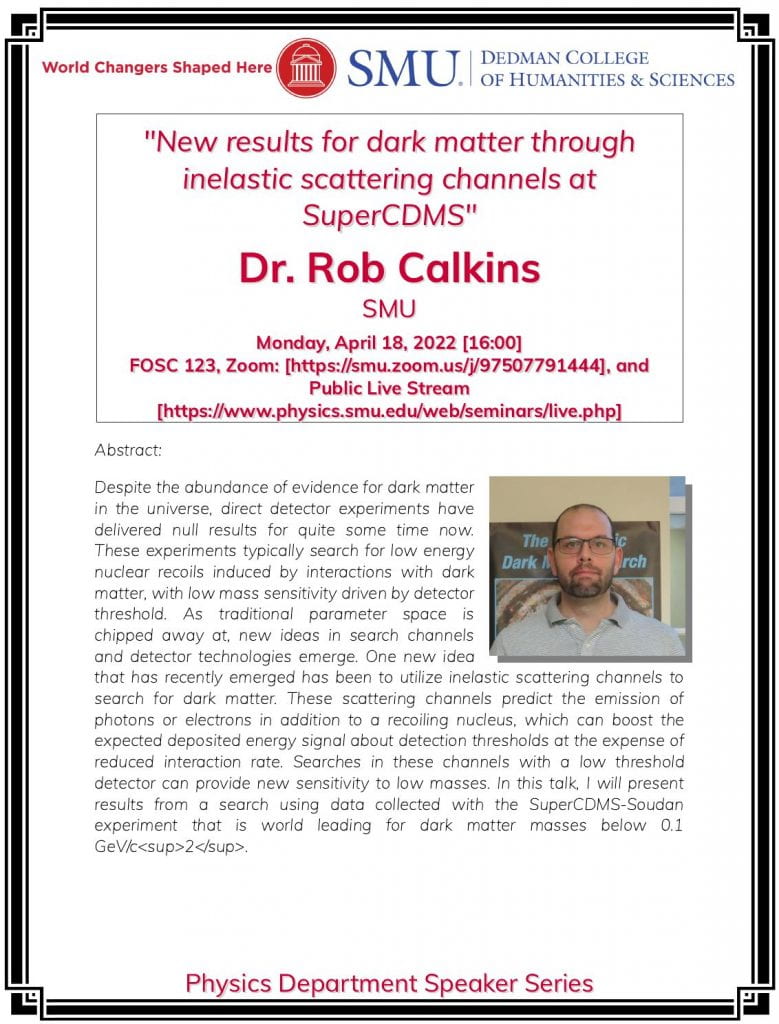
In this edition of the Friday Newsletter, we announce the distinguished speaker for the Spring Colloquium on May 2 and look forward to learning from our amazing alumni!
Continue reading “Physics Department Friday Newsletter for April 22, 2022”
In this edition of the Friday Newsletter, we announce the distinguished speaker for the Spring Colloquium on May 2 and look forward to learning from our amazing alumni!
Continue reading “Physics Department Friday Newsletter for April 22, 2022”Our own research faculty member, Dr. Rob Calkins, will continue the Spring 2022 Department Speaker Series with a lecture entitled “New results for dark matter through inelastic scattering channels at SuperCDMS.” Please find more information below!

Despite the abundance of evidence for dark matter in the universe, direct detector experiments have not observed evidence of particle dark matter within their sensitivity reach. These experiments typically search for low energy nuclear recoils induced by interactions with dark matter, with low mass sensitivity driven by detector threshold. New ideas are required to advance these searches. One that has recently emerged has been to utilize inelastic scattering channels to search for dark matter. These scattering channels predict the emission of photons or electrons in addition to a recoiling nucleus, which can boost the expected deposited energy signal about detection thresholds at the expense of reduced interaction rate, boosting sensitivity to new, lower mass regimes for dark matter. In this talk, I will present results from a search using data collected with the SuperCDMS-Soudan experiment that is world leading for dark matter masses below 10% of the proton’s mass.
Snacks are served in FOSC 16 (The Hyer Ed Cafe) beginning at 3:45 and the talk begins promptly at 4:00pm in FOSC 123. All are welcome!

In this edition of the Friday Newsletter, we celebrate our students’ honors, look forward to the next Speaker Series event, and a physics lab challenge with real consequences and a prize!
Continue reading “Physics Department Friday Newsletter for April 8, 2022”
In this edition of the Friday Newsletter, we celebrate our student researchers and look ahead to the next speaker series event on near-Earth asteroids!
Continue reading “Physics Department Friday Newsletter for April 1, 2022”
In this edition of the Friday Newsletter, we celebrate the success of a student and their forthcoming REU opportunity, the amazing scientific output of the Optoelectronics Lab, and look forward to upcoming research opportunities!
Continue reading “Physics Department Friday Newsletter for March 25, 2022”Prof. Walter Wilcox, friend of the department, colleague, and expert on nuclear and nucleon structure, will continue the Spring 2022 Department Speaker Series with a lecture entitled “Particle Polarizabilities and PDFs from Lattice QCD.” This talk comes right after Spring Break at SMU. Please find more information below!

As techniques are refined and computer power and algorithms improve, a greater number of physical observables are being formed and measured using lattice QCD (LQCD) techniques. A unifying approach to many of these evaluations involves the use of lattice four-point functions. Using these, a set of evaluations called electric and magnetic polarizabilities for pions and nucleons can be measured with LQCD techniques. Although polarizabilities are in themselves interesting fundamental properties, the set of diagrams involved are common to many other hadronic observables, including important quantities called parton distribution functions (PDFs). After some ancient history is discussed, the lattice methods used to extract such quantities will be explained, including specialized techniques for so-called disconnected diagrams.
Snacks are served in FOSC 16 (The Hyer Ed Cafe) beginning at 3:45 and the talk begins promptly at 4:00pm in FOSC 123. All are welcome!

In this edition of the Friday Newsletter, we learn about how to get technology support for your research, look at recycling in the introductory lab course revamp, and enjoy a lovely photo of the moon from a night of sky observing at SMU.
Continue reading “Physics Department Friday Newsletter for March 11, 2022”
In this edition of the Friday Newsletter, we celebrate the accomplishments of one of our Research Faculty, look at Admitted Student Day, and think about the night sky.
Continue reading “Physics Department Friday Newsletter for March 4, 2022”
In this edition of the Friday Newsletter, we meet the newest member of the Physics Phamily and we take a look at Admitted Student Day on March 4.
Continue reading “Physics Department Friday Newsletter for February 25, 2022”
In this edition of the Friday Newsletter, we look at a major publication marking the upgrade of electronics for a key system in the ATLAS Experiment, give a heads up about some possible power outages, and glance at a number of other issues!
Continue reading “Physics Department Friday Newsletter for February 18, 2022”